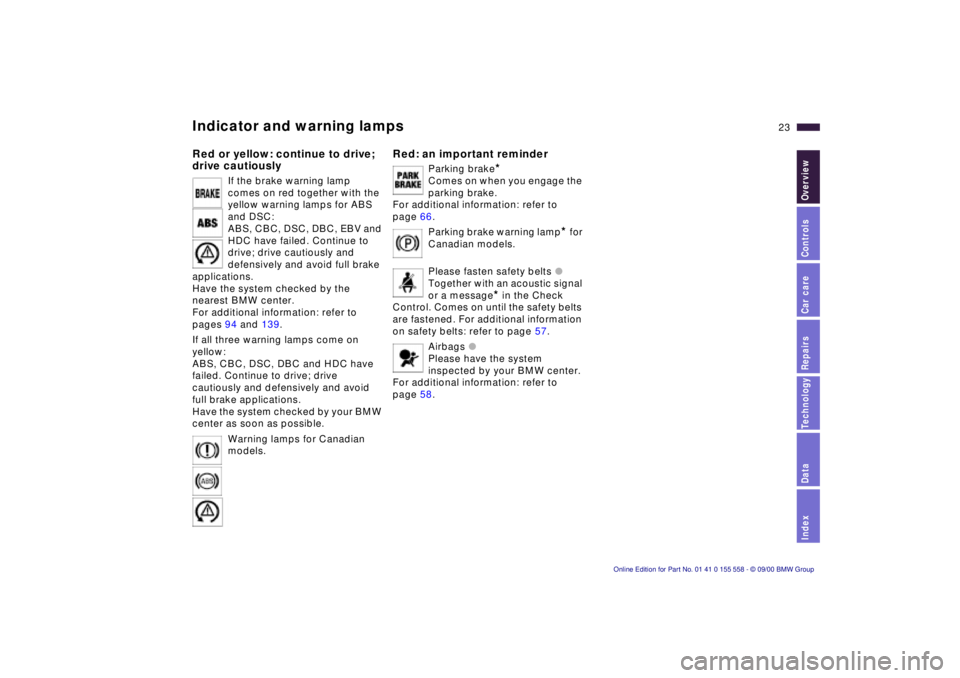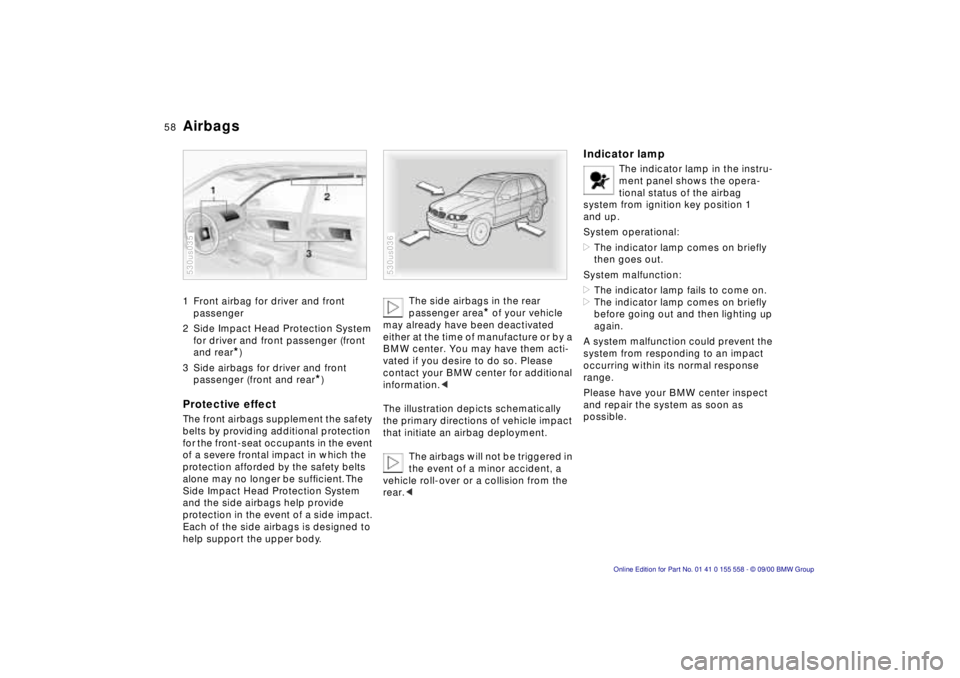2001 BMW X5 3.0I airbag
[x] Cancel search: airbagPage 10 of 223

Contents
Overview
Controls and features
Cockpit 16
Instrument cluster 18
Indicator and warning lamps 22
Multifunction steering wheel 26
Sports steering wheel 27
Hazard warning flashers 28
Warning triangle 28
First-aid kit 28
Refueling 29
Fuel specifications 30
Tire inflation pressure 30
Locks and security systems:
Keys34
Electronic vehicle immobilizer 35
Central locking system 36
Opening and closing – from the outside 36
Using the key 36
Using the remote control 37
Opening and closing – from the inside 40
Liftgate 41
Tailgate 41
Alarm system 43
Electric power windows 45
Sliding/Tilt sunroof with glass moonroof 46
Adjustments:
Seats48
Steering wheel 52
Mirrors 53
Seat, mirror and steering wheel memory 55
Car Memory, Key Memory 56
Passenger safety systems:
Safety belts57
Airbags 58
Transporting children safely 61
Driving:
Steering/Ignition lock64
Starting the engine 64
Switching off the engine 65
Parking brake 66
Manual transmission 67
Automatic transmission with Steptronic 68
Turn signal indicator/Headlamp flasher 70
Washer/Wiper system 71
Rear window defroster 73
Cruise control 74
Everything under control:
Odometer, outside temperature
display 76
Tachometer 77
Energy control 77
Fuel gauge 77
Coolant temperature gauge 78
Service Interval Display 78
Check Control 79
Computer 82
Multi-Information display (MID) 84
Digital clock in the MID 85
Computer in the MID 88
Contents
Page 12 of 223

Contents
Operation, care and maintenanceOwner service proceduresAdvanced technology
Under the hood:
Hood 151
Engine compartment 152
Washer fluid 156
Washer nozzles 156
Engine oil 157
Coolant 160
Brake fluid 161
Vehicle Identification Number 161
Care and maintenance:
The BMW Maintenance
System 162
Caring for your vehicle 163
Airbags 168
Vehicle storage 168
Laws and regulations:
Technical modifications 169
California Proposition 65 Warning 169
OBD interface socket 170
Replacement procedures:
Onboard tool kit174
Windshield wiper blades 174
Lamps and bulbs 175
Changing a wheel 180
Battery 185
Fuses 187
In case of electrical
malfunction:
Fuel filler door 188
Sliding/Tilt sunroof 188
Liftgate 188
Tailgate 189
Assistance, giving and
receiving:
Jump-starting 190
Towing the vehicle 191 Airbags
196
Adaptive Transmission Control (ATC) 196
Four-wheel drive 197
Dynamic Stability Control (DSC) 197
Radio reception 198
Safety belt tensioner 198
DSP sound system 199
Rearview mirrors with automatic dimmer 199
Rain sensor 200
Front axle 200
Integrated rear suspension 201
Level control system 201
Xenon lamps 202
Page 19 of 223

Index
Data
Technology
Repairs
Car care
Controls
Overview
19n
Instrument cluster
There are two versions, depending on
the equipment on your vehicle.
1 Fuel gauge with indicator lamp for fuel reserve 77
2 Indicator lamp for turn signals 25
3 Speedometer
4 Indicator lamp for high beams 25
5 Tachometer and Energy Control 77
6 Coolant temperature gauge with "Coolant temperature too high"
indicator 78
7 Indicator and warning lamps (clockwise) for:
>
Parking brake/Brake hydraulic
system, Dynamic Brake Control
(DBC) 22, 24
>
Antilock Brake System (ABS) 23
>
Brake pads24
>
Airbags23
>
Automatic transmission
*
24
>
Please fasten safety belts 23
>
Cruise control25
8 Selector lever and program display for automatic transmission
*
68
9 Service Interval Display 7810 Computer display –
operation via the turn signal lever,
refer to page 82:
>
Outside temperature
>
Average fuel consumption
>
Cruising range
>
Average speed
11 Indicator lamp for Dynamic Stability Control (DSC) 24
12 Indicator lamp for level control system
*
24
13 Odometer and trip odometer 76
14 Indicator for Check Control 79
15 Reset button for trip odometer 76
16 Indicator and warning lamps (clockwise) for:
>
Fog lamps 25
>
Battery charge current 22
>
Engine oil level/Engine oil
pressure22, 24
>
Engine Power Control 24
>
Service Engine Soon24
Page 21 of 223

Index
Data
Technology
Repairs
Car care
Controls
Overview
21n
Instrument cluster
*
There are two versions, depending on
the equipment on your vehicle. 1 Fuel gauge with indicator lamp for fuel reserve 77
2 Indicator lamp for turn signals 25
3 Speedometer
4 Indicator lamp for high beams 25
5 Tachometer and Energy Control 77
6 Engine coolant temperature gauge 78
7 Indicator and warning lamps (clockwise) for:
>
Parking brake 23
>
Brake hydraulic system/Dynamic
Brake Control (DBC) 22, 24
>
Antilock Brake System (ABS) 23
>
Airbags23
>
Please fasten safety belts 23
>
Cruise control25
8 CHECK button 79
9 Selector lever and program display for automatic transmission
*
68 10 Outside temperature display
76
11 Indicator lamp for Dynamic Stability Control (DSC) 24
12 Trip odometer 76
13 Indicator for Check Control
*
79
14 Odometer 76
15 Service Interval Display 78
16 Reset button for trip odometer 76
17 Indicator and warning lamps (clockwise) for:
>
Fog lamps 25
>
Battery charge current 22
>
Engine oil pressure22
>
Service Engine Soon 24
Page 23 of 223

Index
Data
Technology
Repairs
Car care
Controls
Overview
23nIndicator and warning lamps
Red or yellow: continue to drive;
drive cautiously
If the brake warning lamp
comes on red together with the
yellow warning lamps for ABS
and DSC:
ABS, CBC, DSC, DBC, EBV and
HDC have failed. Continue to
drive; drive cautiously and
defensively and avoid full brake
applications.
Have the system checked by the
nearest BMW center.
For additional information: refer to
pages 94 and 139.
If all three warning lamps come on
yellow:
ABS, CBC, DSC, DBC and HDC have
failed. Continue to drive; drive
cautiously and defensively and avoid
full brake applications.
Have the system checked by your BMW
center as soon as possible. Warning lamps for Canadian
models.
Red: an important reminder
Parking brake*
Comes on when you engage the
parking brake.
For additional information: refer to
page 66.
Parking brake warning lamp
* for
Canadian models.
Please fasten safety belts l
Together with an acoustic signal
or a message
* in the Check
Control. Comes on until the safety belts
are fastened. For additional information
on safety belts: refer to page 57.
Airbags l
Please have the system
inspected by your BMW center.
For additional information: refer to
page 58.
Page 32 of 223

32n
Locks and security systems:
Keys 34
Electronic vehicle immobilizer 35
Central locking system 36
Opening and closing – from the outside 36
Using the key 36
Using the remote control 37
Opening and closing – from the inside 40
Liftgate 41
Tailgate 41
Alarm system 43
Electric power windows 45
Sliding/Tilt sunroof with glass moonroof 46
Adjustments:
Seats 48
Steering wheel 52
Mirrors 53
Seat, mirror and steering wheel memory 55
Car Memory, Key Memory 56
Passenger safety systems:
Safety belts 57
Airbags 58
Transporting children safely 61Driving:
Steering/Ignition lock
64
Starting the engine 64
Switching off the engine 65
Parking brake 66
Manual transmission 67
Automatic transmission with Steptronic 68
Turn signal indicator/Headlamp flasher 70
Washer/Wiper system/Rain sensor 71
Rear window defroster 73
Cruise control 74
Everything under control:
Odometer, outside temperature display 76
Tachometer 77
Energy control 77
Fuel gauge 77
Coolant temperature gauge 78
Service Interval Display 78
Check Control 79
Computer 82
Multi-Information Display
(MID) 84
Digital clock in the MID 85
Computer in the MID 88
Controls
Page 58 of 223

58nAirbags
1 Front airbag for driver and front
passenger
2 Side Impact Head Protection System for driver and front passenger (front
and rear
*)
3 Side airbags for driver and front passenger (front and rear
*)
Protective effect
The front airbags supplement the safety
belts by providing additional protection
for the front-seat occupants in the event
of a severe frontal impact in which the
protection afforded by the safety belts
alone may no longer be sufficient. The
Side Impact Head Protection System
and the side airbags help provide
protection in the event of a side impact.
Each of the side airbags is designed to
help support the upper body.
530us035
The side airbags in the rear
passenger area
* of your vehicle
may already have been deactivated
either at the time of manufacture or by a
BMW center. You may have them acti-
vated if you desire to do so. Please
contact your BMW center for additional
information. <
The illustration depicts schematically
the primary directions of vehicle impact
that initiate an airbag deployment. The airbags will not be triggered in
the event of a minor accident, a
vehicle roll-over or a collision from the
rear. <
530us036
Indicator lamp
The indicator lamp in the instru-
ment panel shows the opera-
tional status of the airbag
system from ignition key position 1
and up.
System operational:
> The indicator lamp comes on briefly
then goes out.
System malfunction:
> The indicator lamp fails to come on.
> The indicator lamp comes on briefly
before going out and then lighting up
again.
A system malfunction could prevent the
system from responding to an impact
occurring within its normal response
range.
Please have your BMW center inspect
and repair the system as soon as
possible.
Page 59 of 223

Index
Data
Technology
Repairs
Car care
Controls
Overview
59nAirbags
Sitting correctly with airbags
For your safety, comply with the
following instructions for the
airbags. If you do not, the airbags may
not be able to provide their maximum
protection. All passengers in the vehicle
should be aware of and comply with
this information:
Even though there is an airbag, wear a
safety belt every time you get in the
vehicle, because airbags enhance
safety by providing added protection.
Make sure you are seated comfortably
in your seat, in such a way that you
always maintain control, and are not too
close to the steering wheel.
Always hold the steering wheel by the
rim to keep any chance of injury to
hands or arms to an absolute minimum,
should the airbag be deployed.
No one and nothing is to come between
the airbag and the seat occupant.
Do not use the cover panel above the
front passenger-side airbag as a
storage area.
Do not apply adhesive materials to the
cover panels of the airbags, cover them
or modify them in any other way.
Do not install a rear-facing child
restraint system in the front passenger
seat of this car.
Children under 13 years of age and
children less than 5 feet (150 cm) tall
should ride only in the rear seat.
Infants or small children should never
be held on the lap of a passenger.
If your car is equipped with side airbags
in the rear passenger area, be sure that
child restraints are mounted correctly
and provided with the greatest-possible
distance between the airbags in the
side trim panels. Do not allow children
to lean out of the child's seat in the
direction of the side trim panels. If they
do so, serious injuries can occur if the
airbag is triggered. < At all times, occupants should sit
upright and be properly restrained
(infants and small children in appro-
priate child restraint systems; larger
children and adults using the safety
belts). Never let an occupant's head
rest near or on a side airbag because
the inflating airbag could cause a
serious or fatal injury. Please note that
the word "Airbag" imprinted on the door
trim panel indicates the airbag's loca-
tion.
Accident research shows that the
safest place for children in an auto-
mobile is in the rear seat. However, a
child sitting in the rear seat and not
properly restrained may place his or her
head on or near the airbag, if so
equipped.
For example, a child — even though
belted — may fall asleep with his or her
head against the side airbag. It may be
difficult for a driver to ensure that chil-
dren in the rear seat will remain prop-
erly positioned at all times and do not
place their heads on or near the side
airbag. Therefore, we recommend that
the rear side airbags, if provided, be
deactivated if you plan to transport
children in the rear seat.